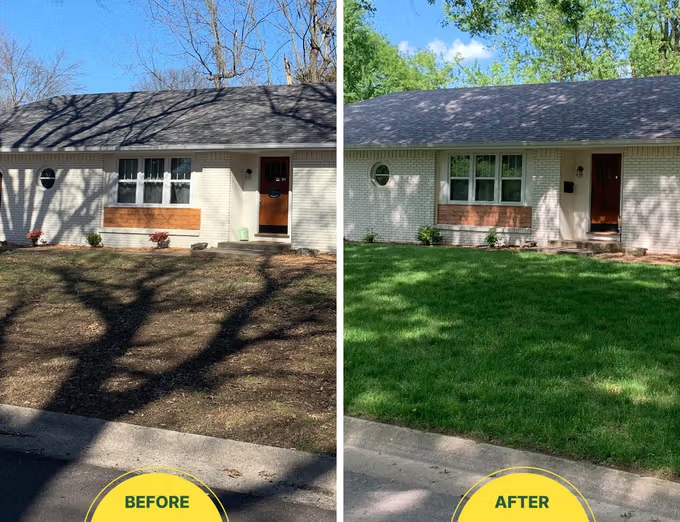Tips to Fix Bare Patches On Your Lawn This Spring
Last Updated on April 29, 2025 by Duncan
Spring has arrived, and with it comes the ideal opportunity to give your grass some much-needed attention.
If you’ve noticed bare patches of grass that make your yard appear worn or uneven, now’s the time to remedy them. These holes could have been produced by dogs, foot traffic, vermin, or even extreme weather, but they don’t have to last.
Fortunately, restoring a patchy lawn is easier than you would expect. Whether you decide to reseed or lay new turf, spring’s mild temperatures and consistent rainfall provide ideal circumstances for new growth to take root.
Prepare the bare spot.
To remove damaged turf, use a flat-bladed spade or a half-moon edging tool. Then, aim for a clean, square cut that is approximately 5 cm deep. This makes mixing the fix simpler.
Use a fork to loosen the soil underneath, and then mix in some fresh topsoil or compost.
To produce an even base, gently press down on the surface with your foot.
Decide between seed and turf.
There are two ways to fix a patch, each with its advantages and disadvantages.
Grass seed is less expensive, more readily available, and easier to distribute. You will have to wait a few weeks to notice the effects.
Turf, on the other hand, is instant and looks fantastic right away, but it is more expensive and requires proper integration with the surrounding lawn.
In shaded areas, consider a low-light seed mix, while in high-traffic areas, select a hardy type.
If you are harvesting turf from another section of your garden, make sure to patch it as well.
In northern cold-winter zones, the most common cool-season grasses thrive in late summer and fall, making it a good time for seeding patches. However, you can also seed in early spring, as long as you do it early enough for the grass to be fully established by the scorching mid-summer months.
In warm-winter regions where warm-season grasses predominate, late spring and early summer are the best times to sow grass seed.
Patching with sod gives you a wider range of options. Professional guidelines for sodding a full yard are similar to those for seeding: early fall for cool-season grasses and late spring for warm-season grasses.
However, if you are cutting patches to cover bare areas, you should be successful for the majority of the growing season as long as you keep the sod patch moist while it is establishing itself. Remember that sod supplies in garden centers are seasonal in many areas, so don’t wait too long.
Sod will form a superficial root system in about two weeks, while a deep root system can take up to six weeks. If you reside in an area where strong frost occurs in early December, for example, it is advisable to sow sod patches by mid-October.
How to reseed bare patches
Seeding is an economical and straightforward way to mend barren patches. It simply requires approximately 20 minutes of your time, plus minor maintenance till the first or second mowing.
The disadvantage is that the patch will take several weeks to be mowable and up to six months to integrate into the rest of your grass fully.
Step 1: Rake the area
Use a garden rake to remove any debris or dead grass from the area. Now is also the time to inspect the region for grub damage. If the damaged section of the lawn comes up easily, as if a rug were pulled, you may have a grub problem that has to be addressed.
Step 2: Loosen the soil
Use a garden cultivator or a hard-toothed lawn rake to break up the dirt. If the soil appears to be extremely compacted, consider aerating it with a core aeration tool. When you push this simple manual instrument into the soil with your foot, it creates aeration holes.
Step 3: Fix the soil
Sprinkle a few inches of compost or loamy soil over the existing dirt and rake it in. Turn the rake upside down and use the top edge to level the surface, dispersing some of the topdressing into the surrounding areas.
Step 4: Spread the seeds
Sprinkle the grass seed evenly across the patch area, thick enough to cover the surface but not so dense that the seeds pile up on top of one another. For a great experience, choose a seed that is suited for your region and microclimate (sun or shade). Add perennial ryegrass, which germinates quickly to the blend.
Tip
Don’t fertilize yet. While this stage was traditionally recommended, most experts believe that fertilizers are ineffective until the grasses are fully established.
Step 5: Rake the seeds
To ensure fair distribution, lightly rake in the seed. This will also cover a portion of the seed with a thin coating of soil, helping to keep it in place. Until the seeds germinate, you may need to protect the area from birds, which enjoy eating the seed and emerging shoots. Use reflective tape or pinwheels set on short stakes to dissuade them.
Step 6: Begin watering
Lightly water the area. Keep the seeds wet all day. If hot weather is an issue, use a covering of burlap to cover the patch. This will give shade and prevent the developing seeds from drying.
Another approach is to sprinkle a thin layer of wheat straw over the sown area to keep the seeds in place and moist.
For the first 10 days or so, your patch area will need to be lightly watered daily—if not twice daily—until the seeds germinate and sprout. Keep watering every two days for another month or so, then reduce watering to weekly as the young grass matures.
Step 7: Mow when ready
Allow the grass to grow a little longer than the rest of your lawn until the color of the mended area blends in. This could mean mowing around it for two or three mowing rounds. Some seed manufacturers recommend waiting at least seven weeks before mowing fresh grass.
How to patch bare patches with sod
Filling the bare area with a patch cut from a roll of grass sod is a faster alternative to seeding. This is an effective strategy if you have multiple bare regions to treat.
A roll of sod often costs a few dollars, and you can cut multiple patches from a single roll. Within a few weeks, you’ll have a suitable patch that blends in with the surrounding grass.
Step 1: Cut the sod patch
Using a sharp shovel or garden knife, cut a patch of sod grass somewhat larger than the bare space in your yard. The patch should extend approximately 2 inches beyond the bare spot’s margins into the healthy grass region.
Step 2: Cut out the old turf
Place the sod patch over the bare area. Using a sharp shovel or garden knife, “trace” around the sod patch into the healthy lawn surrounding the bare area.
You should remove the sod patch, then use a hand cultivator to remove the dead grass and the healthy grass ring surrounding the bare piece. Remove a layer of soil beneath the grass: The idea is to dig down slightly so that the sod patch is level with the rest of your lawn.
Step 3: Prepare the soil
To loosen the soil in your patch area, use a shovel, garden rake, or cultivator. The soil should be loose enough to allow the sod patch’s roots to grow down swiftly and anchor in the soil.
Step 4: Plant the sod patch
Place the sod patch in the dug area and walk on it several times to compress it. Water immediately, then twice or three times every day for a couple of days, until the sod patch has bonded and is actively growing.
Within two weeks, your sod patch should be seamless and indistinguishable from the rest of your grass, but it may take up to six weeks to become fully planted. Don’t be shocked if it’s a bit different color at first; this will fade quickly.
Tip
Sod mats are available in a variety of sizes, ranging from little slabs (16×24 inches) to bigger mats or rolls measuring 2 feet wide and 5 feet long, each covering 10 square feet. If you are only preparing small areas of your lawn, seeding is preferable to cutting sod to size.


